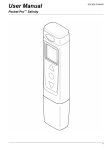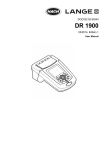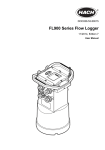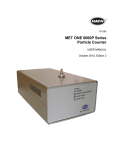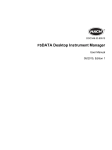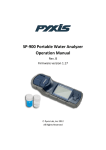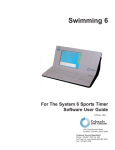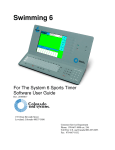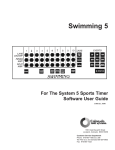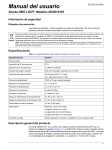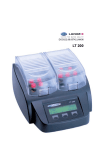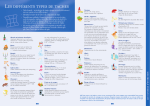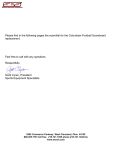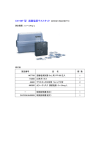Download Storm Water Test Kit - Fondriest Environmental
Transcript
DOC326.97.00024 Storm Water Test Kit 11/2013, Edition 1 User Manual Table of Contents General information ..................................................................................................3 Safety information ........................................................................................................3 Use of hazard information ....................................................................................3 Precautionary labels .............................................................................................3 Product overview .........................................................................................................3 Product components ....................................................................................................5 Total Chlorine ..............................................................................................................6 Test preparation ........................................................................................................... 6 Total Chlorine (0–3.4 mg/L) test procedure ................................................................. 6 Replacement items ......................................................................................................6 Total Copper .................................................................................................................8 Test preparation ........................................................................................................... 8 Free and Total Copper (0-4 mg/L) test procedure ....................................................... 8 Interferences ................................................................................................................9 Accuracy check ............................................................................................................ 9 Replacement items ....................................................................................................10 Optional items ............................................................................................................10 Detergents ...................................................................................................................11 Test preparation ......................................................................................................... 11 Detergents (0–1.2 mg/L) test procedure .................................................................... 11 Replacement items ....................................................................................................12 pH ....................................................................................................................................14 Phenols .........................................................................................................................14 Test preparation ......................................................................................................... 14 Phenols (0–4 mg/L) test procedure ...........................................................................15 Replacement items ....................................................................................................15 Optional items ............................................................................................................16 1 Table of Contents 2 General information In no event will the manufacturer be liable for direct, indirect, special, incidental or consequential damages resulting from any defect or omission in this manual. The manufacturer reserves the right to make changes in this manual and the products it describes at any time, without notice or obligation. Revised editions are found on the manufacturer’s website. Safety information NOTICE The manufacturer is not responsible for any damages due to misapplication or misuse of this product including, without limitation, direct, incidental and consequential damages, and disclaims such damages to the full extent permitted under applicable law. The user is solely responsible to identify critical application risks and install appropriate mechanisms to protect processes during a possible equipment malfunction. Please read this entire manual before unpacking, setting up or operating this equipment. Pay attention to all danger and caution statements. Failure to do so could result in serious injury to the operator or damage to the equipment. Make sure that the protection provided by this equipment is not impaired. Do not use or install this equipment in any manner other than that specified in this manual. Use of hazard information DANGER Indicates a potentially or imminently hazardous situation which, if not avoided, will result in death or serious injury. WARNING Indicates a potentially or imminently hazardous situation which, if not avoided, could result in death or serious injury. CAUTION Indicates a potentially hazardous situation that may result in minor or moderate injury. NOTICE Indicates a situation which, if not avoided, may cause damage to the instrument. Information that requires special emphasis. Precautionary labels Read all labels and tags attached to the instrument. Personal injury or damage to the instrument could occur if not observed. A symbol on the instrument is referenced in the manual with a precautionary statement. Electrical equipment marked with this symbol may not be disposed of in European public disposal systems after 12 August of 2005. In conformity with European local and national regulations (EU Directive 2002/96/EC), European electrical equipment users must now return old or end-of-life equipment to the Producer for disposal at no charge to the user. Note: For return for recycling, please contact the equipment producer or supplier for instructions on how to return endof-life equipment, producer-supplied electrical accessories, and all auxiliary items for proper disposal. Product overview WARNING Chemical exposure hazard. Obey laboratory safety procedures and wear all of the personal protective equipment appropriate to the chemicals that are handled. Refer to the current safety data sheets (MSDS/SDS) for safety protocols. English 3 Environmental Protection Agency (EPA) studies show that storm water runoff carries pollutants to nearby lakes, rivers and streams. To protect receiving waters, the EPA issued regulations* in November 1990 which apply to both municipalities and industrial storm water discharges. Part 1 of the NPDES (National Pollutant Discharge Elimination System) application requires municipalities to do field screening with grab samples collected from dry weather flows. These samples will be analyzed for pH, total chlorine, total phenols, total copper and detergents. Use this test kit on-site or in a laboratory to identify the pH level and the concentrations of total chlorine, total phenols, total copper and detergents in storm sewer outflow and industrial discharge. Refer to Table 1 for the test kit parameters. A color comparator box and color discs are used to identify the concentration of total chlorine, total phenols, total copper and detergents. Refer to Figure 1. The Pocket Pro pH tester is used to identify the pH level. Table 1 Test kit parameters Parameter Range Number of tests pH 0–14 Refer to packaging Ion selective electrode Type of test Chlorine, total 0–3.4 mg/L 100 Sensitivity Refer to packaging DPD 0.1 mg/L Copper, free and total 0–4 mg/L 100 Bicinchoninate Hydrosulfite reduction 0.1 mg/L Phenol 0–4 100 4-aminoantipyrine 0.1 mg/L Detergents 0–1.2 mg/L 32 Toluidine Blue-O 0.05 mg/L Figure 1 Color comparator box 1 Color matching windows 4 Scale window 2 Opening for tube with untreated sample 5 Color disc 3 Opening for tube with prepared sample * Federal Register, November 16, 1990. 4 English Product components Make sure that all components have been received. Refer to the list that follows. If any items are missing or damaged, contact the manufacturer or a sales representative immediately. • • • • • • • • • • • • Pocket Pro™ pH tester Color discs (4x) Color viewing tubes with caps (4x) Color comparator box Carrying case Chloroform, ACS grade Detergents Test Solution Wash Water Buffer (2x) Hardness 1 Buffer Solution Filtering thimble Test tube, 10-mL (2x) Draw-off pipet • • • • • • • • • • • • Stopper for color viewing tubes Phenol Reagent Powder Pillows Hydrosulfite Reagent Powder Pillows Free Copper Reagent Powder Pillows EDTA Reagent Powder Pillows DPD Total Chlorine Reagent Powder Pillows Potassium Persulfate Powder Pillows pH 7.0 SINGLET™ buffer solution packs Dropper Beaker, 100-mL Demineralizer bottle Glass wool for detergents test English 5 Total Chlorine Test preparation • Assemble the color comparator. Put the DPD Chlorine color disc on the center pin with the lettering facing out. • Use sunlight or a fluorescent light source to compare colors. • Rinse all viewing tubes with the sample water before testing and between tests. • Accuracy is not affected by undissolved powder. • If the disc becomes wet, carefully open the plastic case. Dry the case and the color insert with a soft cloth. Assemble the case when the parts are completely dry. Total Chlorine (0–3.4 mg/L) test procedure 1. Fill one color viewing tube to the lower edge of the frosted area (5-mL mark) with clear water. 2. Put the tube into the left opening on the top of the comparator. 3. Fill a second color viewing tube to the lower edge of the frosted area (5-mL mark) with the water sample. 4. Add the contents of one DPD Total Chlorine Reagent Powder Pillow. 5. Swirl to mix. 6. A color will develop if chlorine is present in the sample. Wait 3–6 minutes for full color development. 7. Put the tube into the right opening on the top of the comparator. Hold the comparator in front of a light source. Turn the disc to find a color match. 8. Read the mg/L total chlorine (Cl2) from the scale window. If the result is between two values, use the value halfway between the two printed numbers. Replacement items Note: Product and Article numbers may vary for some selling regions. Contact the appropriate distributor or refer to the company website for contact information. Description Unit Item no. 1 173200 Color viewing tubes with caps 4/pkg 4660004 DPD Chlorine disc, 0–3.4 mg/L 1 990200 Color comparator box 6 English Description DPD Total Chlorine Reagent Powder Pillows Caps for color viewing tubes Unit Item no. 100/pkg 1407699 4/pkg 4660014 English 7 Total Copper Test preparation This test procedure identifies the concentration of free or complexed copper. Free copper refers to any free or weakly chelated copper ion in solution. Complexed (chelated) copper is tightly bound, as in Cu (EDTA). Free copper plus complexed copper gives the total dissolved copper. • Assemble the color comparator. Put the copper color disc on the center pin with the lettering facing out. • Use sunlight or a fluorescent light source to compare colors. • Rinse all viewing tubes with the sample water before testing and between tests. • Accuracy is not affected by undissolved powder. • Refer to Table 2 on page 9 for interfering substances. • If the disc becomes wet, carefully open the plastic case. Dry the case and the color insert with a soft cloth. Assemble the case when the parts are completely dry. Free and Total Copper (0-4 mg/L) test procedure 1. Fill two color viewing tubes to the lower edge of the frosted area (5-mL mark) with the water sample. 2. Add the contents of one Free Copper Reagent Powder Pillow to one of the tubes. 3. Put a stopper in the tube with the powder. Invert the tube several times to mix. 4. A purple color will develop if free copper is present in the sample. Wait 2 minutes for full color development. 5. Put the untreated sample tube into the left opening on the top of the comparator. 6. Put the prepared sample tube into the right opening on the top of the comparator. Hold the comparator in front of a light source. Turn the disc to find a color match. 7. Read the mg/L free copper (Cu) from the scale window. If the result is between two values, use the value halfway between the two printed numbers. 8. To identify the concentration of total dissolved copper present, add the contents of one Hydrosulfite Reagent Powder Pillow (clear pillow) to the tube. 8 English 9. Put a stopper in the tube. Remove the tube from the comparator. Invert the tube several times to mix. 10. Wait 2 minutes for full color development. 11. Put the prepared sample tube back into the right opening on the top of the comparator. Hold the comparator in front of a light source. Turn the disc to find a color match. 12. Read the mg/L total dissolved copper (free copper and complexed copper) from the scale window. If the result is between two values, use the value halfway between the two printed numbers. 13. To identify the concentration of complexed copper present in the sample, subtract the amount of free copper from the amount of total dissolved copper. Interferences Table 2 Interfering substances Interfering substance Interference level Cyanide More than 2 mg/L inhibits color development Add three drops of Formaldehyde Solution before the viewing tube is put into the comparator box. Wait 3 minutes and then read the mg/L free copper. Accuracy check Periodically identify the reagent accuracy with a reliable standard such as Copper Standard Solution 10-mg/L. 1. Prepare a 2 mg/L free copper solution. a. Carefully measure 1 mL of Copper Standard Solution 10-mg/L into a sample tube. b. Add deionized water to the sample tube to the 5 mL mark. 2. Identify the concentration of copper that is present in the standard. Refer to Free and Total Copper (0-4 mg/L) test procedure on page 8. English 9 Replacement items Note: Product and Article numbers may vary for some selling regions. Contact the appropriate distributor or refer to the company website for contact information. Description Unit Item no. Color comparator box Color viewing tubes with caps 1 173200 6/pkg 173006 Copper color disc 1 9263300 Free Copper Reagent Powder Pillow 100/pkg 2182369 Hydrosulfite Reagent Powder Pillow 100/pkg 2118869 6/pkg 173106 Stoppers for viewing tubes Optional items Description Unit Item no. Copper Standard Solution 10 mg/L 100 mL MDB 12932 Formaldehyde Solution 100 mL SCBD 205932 10 English Detergents Test preparation • Assemble the color comparator. Put the Detergents color disc on the center pin with the lettering facing out. • Use sunlight or a fluorescent light source to compare colors. • Rinse all viewing tubes with the sample water before testing and between tests. • If the disc becomes wet, carefully open the plastic case. Dry the case and the color insert with a soft cloth. Assemble the case when the parts are completely dry. Filter the chloroform layer If the water sample is turbid, filter the chloroform layer at step 13. 1. Put a small ball (about the size of a large pea) of glass wool in the filter thimble. 2. Use the draw-off pipet to remove the chloroform. Filter the chloroform through the glass wool and into an unused, glass test tube. Detergents (0–1.2 mg/L) test procedure 1. Fill one test tube to the upper mark (20 mL) with the water sample. 2. Add 12 drops of Detergent Test Solution. 3. Put the stopper in the tube. Shake to mix. 4. Add chloroform to the lowest mark (5 mL). Chloroform is heavier than water and will go to the bottom of the tube. 5. Put the stopper in the tube. Shake vigorously for 30 seconds. 6. Do not touch the tube for 1 minute to let the chloroform separate. 7. Use the draw-off pipet to remove the water from the tube. Discard the water. 8. Add Wash Water Buffer to the upper mark (20 mL). English 11 9. Use the draw-off pipet to remove the Wash Water Buffer. Discard the buffer. Note: This step washes away the remaining water sample. 10. Add Wash Water Buffer to the upper mark (20 mL). 11. Put the stopper in the tube. Shake vigorously for 30 seconds. 12. Do not touch the tube for 1 minute to let the chloroform separate. 13. If the water sample is turbid, filter the chloroform layer. 14. Put the prepared sample tube into the right opening on the top of the comparator. 15. Fill a second test tube with deionized water. 16. Put the deionized water tube into the left opening on the top of the comparator. Hold the comparator in front of a light source. Turn the disc to find a color match. 17. Read the ppm Detergents (LAS and/or ABS) from the scale window. If the result is between two values, use the value halfway between the two printed numbers. If the color is darker than the highest reading on the color disc, do steps 18–20 to make a 20-to-1 dilution. 18. Discard the contents of the prepared sample tube (in the right opening). Rinse the tube with deionized water. Use the dropper to add 1 mL of the water sample to the tube. 19. Add deionized water to the upper mark (20 mL). 20. Do steps 2–17 and multiply the results by 20. Replacement items Note: Product and Article numbers may vary for some selling regions. Contact the appropriate distributor or refer to the company website for contact information. 12 English Description Bulb for draw-off pipette Color comparator box Color viewing tubes with caps, 5 mL and 20 mL marks Chloroform, ACS grade (approximately 100 tests) Detergents color disc, 0–1.2 mg/L Detergents reagent Dropper, 0.5 mL and 1.0 mL marks Quantity Item no. 1 178600 1 173200 6/pkg 173606 500 mL 1445849 1 9265700 100 mL MDB 105932 5/pkg 1419700 Filtering thimble 1 51200 Glass tube for draw-off pipette 1 221800 Glass wool 5g 252074 Test tube 10/pkg 56510 Wash Water Buffer (approximately 32 tests) 500 mL 99949 English 13 pH Refer to the documentation supplied with the Pocket Pro™ pH tester to do a pH measurement. Phenols Test preparation • Assemble the color comparator. Put the Phenols color disc on the center pin with the lettering facing out. • Use sunlight or a fluorescent light source to compare colors. • Rinse all viewing tubes with the sample water before testing and between tests. • If the disc becomes wet, carefully open the plastic case. Dry the case and the color insert with a soft cloth. Assemble the case when the parts are completely dry. Filter the sample If the sample is turbid, it may be necessary to filter the sample. 1. Install a 0.45 micron filter disc in the filter holder. Refer to Figure 2. Make sure that the holder is closed tight after the disc is installed. 2. Fill the 30-cc syringe with the turbid sample. 3. Attach the filter holder to the syringe with a twisting motion. 4. Filter the sample directly into the viewing tubes from the syringe. Use the filtered sample in the test procedure. Figure 2 Assemble the filter assembly 1 Filter disc 14 English 2 O-ring Phenols (0–4 mg/L) test procedure 1. Fill two color viewing tubes to the upper mark (20 mL) with water sample. 2. Add the contents of one EDTA Reagent Powder Pillow to each tube. 3. Put the cap on each tube and swirl until the powder is dissolved. 4. Add 15 drops of Hardness 1 Buffer Solution to each tube. 5. Put the cap on each tube and swirl. 6. Put one of the tubes into the left opening on the top of the comparator. 7. Add the contents of one Phenol Reagent Powder Pillow for nonextraction method to the second tube. 8. Put the cap on the tube and swirl until the powder is dissolved. 9. Add the contents of one Potassium Persulfate Powder Pillow for Phosphonate to the second tube. 10. Put the cap on the tube and swirl until the powder is dissolved. 11. Put the second tube into the right opening on the top of the comparator. Hold the comparator in front of a light source. Turn the disc to find a color match. 12. Read the result in mg/L from the scale window. If the result is between two values, use the value halfway between the two printed numbers. Replacement items Note: Product and Article numbers may vary for some selling regions. Contact the appropriate distributor or refer to the company website for contact information. Description Color comparator box Color viewing tubes Quantity Item no. 1 173200 4/pkg 4660004 English 15 Description Quantity Item no. 1 93600 EDTA Reagent Powder Pillows 50/pkg 700599 Hardness 1 Buffer Solution 50 mL 42426 Phenol Reagent Powder Pillows (nonextraction) 100/pkg 2481569 Potassium Persulfate Powder Pillows for Phosphonate 100/pkg 2084769 Clippers for powder pillows Optional items Description Filter discs, 25 mm, 45 micron Quantity Item no. 25/pkg 2209525 Filter holder for Luer-Lok 1 246800 Syringe, 30 cc, Luer-Lok tip 1 2225800 16 English HACH COMPANY World Headquarters P.O. Box 389, Loveland, CO 80539-0389 U.S.A. Tel. (970) 669-3050 (800) 227-4224 (U.S.A. only) Fax (970) 669-2932 [email protected] www.hach.com © HACH LANGE GMBH Willstätterstraße 11 D-40549 Düsseldorf, Germany Tel. +49 (0) 2 11 52 88-320 Fax +49 (0) 2 11 52 88-210 [email protected] www.hach-lange.de Hach Company/Hach Lange GmbH, 2013. All rights reserved. Printed in U.S.A. HACH LANGE Sàrl 6, route de Compois 1222 Vésenaz SWITZERLAND Tel. +41 22 594 6400 Fax +41 22 594 6499




















